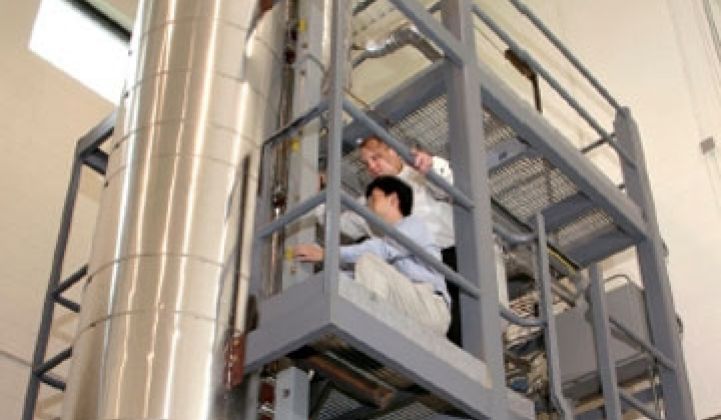In nuclear, smaller is better, argues NuScale Power.
The company – which grew out of research conducted by the Department of Energy and Oregon State – says that it can increase the safety of nuclear power plants and reduce the onerous construction jobs that go with them by building 540 megawatt to 1 gigawatt nuclear power plants with small, modular reactors that each generate 45 megawatts each instead of traditional centralized reactors that crank out hundreds of megawatts.
Experts who reviewed NuScale's passive water cooling system for the reactors declared that it was "exponentially safer" than traditional systems, said Bruce Landrey, who runs business development for NuScale.
Additionally, modular construction won't force up the price. A 540-megawatt power plant made from 12 of NuScale's 45-megawatt reactors could produce power for 6 to 9 cents a kilowatt hour on average over the plant's lifetime Landrey added.
Assuming that price – which does not include additional incentives or subsidies – can be achieved, small nuclear plants would be competitive with fossil fuel, close to wind and cost less than solar. The average blended price of electricity in the U.S. is 9.78 cents per kilowatt hour, according to the Department of Energy. Wind can cost less than 5 cents per kilowatt hour with credits but descending over time, according to the American Wind Energy Association. Others peg it slightly higher. Solar goes for 11 to 19 cents with subsidies and 25 to 35 cents without. Nuclear can also provide baseline power that isn't subject to the weather.
"Our principal market is the conventional market for providing power to the grid," he said. "We anticipate that the costs will be competitive, perhaps slightly less than the larger [nuclear] plants."
Whether or not small nuclear takes off, expect to hear more about it. Next week, Energy Northwest, a joint venture between utilities in the Pacific Northwest, will release a report about the feasibility of one day deploying modular nuclear plants.
Hyperion Power Generation and TerraPower, two other startups, have talked about installing small nuclear reactors for outlying communities or military bases. Conceivably, these small reactors could be networked into a modular array. Established nuclear companies in France, Japan and the U.S. are also examining modular construction.
It will take time. NuScale currently is preparing its application for design certification. It won't likely submit it to the U.S. Nuclear Regulatory Agency until mid-2011 and it will take about three years for the agency to review it. (There are 104 commercial nuclear reactors that exist in the U.S.)
The first plant built from NuScale's modular reactors, therefore, may not go live until 2018, he said.
Critics, no doubt, will also intensely scrutinize any plans for these reactors. Although public opinion polls show nuclear gaining favor among Americans, strong opposition remains. Investors and banks too will chime in: The nuclear industry has a long history of cost overruns and delays and steel and other raw materials have only increased in price since the 1970s. Nuclear power is one of the cheapest forms of power today, groups like the Nuclear Energy Institute like to point out, but that's because the capital costs of the decades-old plants has been amortized. The 6 to 9 cent figure to many will be like waving a red flag in front of a bull. Like conventional reactors, modular reactors produce nuclear waste too.
Like PCs, the advantages of modular nuclear power plants comes from the fact the core tools – computers or power-generating reactors – are split up. If a problem occurs in one reactor, it can't spread to the others. Ideally, the remaining 11 can continue to even provide power.
One of the main design advantages is the passive cooling system. The reactor, which measures 14 feet in diameter, effectively sits inside of a water filled chamber that measures 60-feet long and is constructed out of three-inch thick steel walls. As water passes over the hot fuel, it heats up and rises, drawing cooler water from below. The hot water then cools off and sinks itself.
Traditional nuclear plants rely on an ornate web of pipes and pumps, which can fail. (General Electric and Westinghouse are also proponents of passive cooling.)
"It eliminates a lot of the piping," he said.
Image via NuScale Power.



